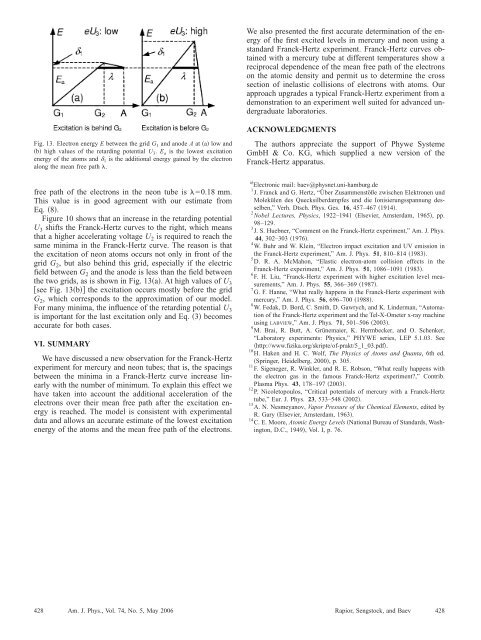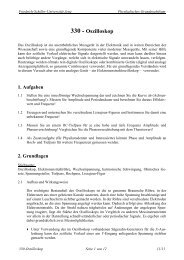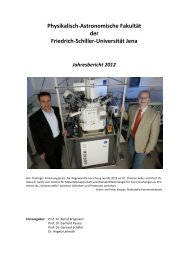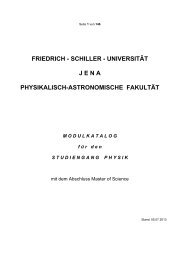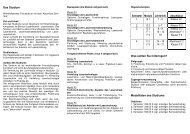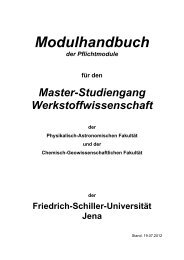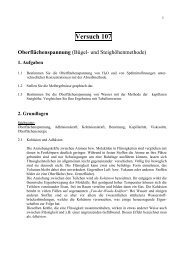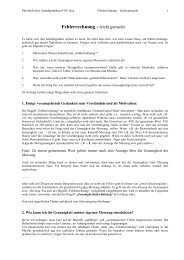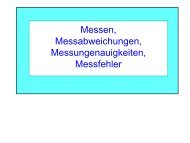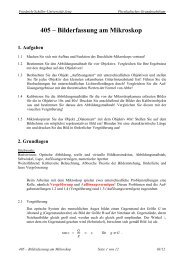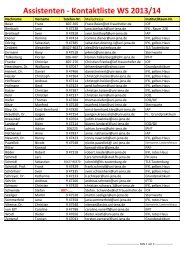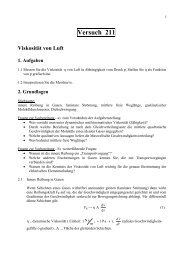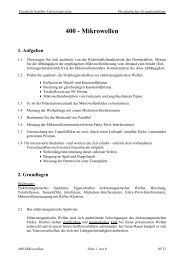New features of the Franck-Hertz experiment - Grundpraktikum Physik
New features of the Franck-Hertz experiment - Grundpraktikum Physik
New features of the Franck-Hertz experiment - Grundpraktikum Physik
Create successful ePaper yourself
Turn your PDF publications into a flip-book with our unique Google optimized e-Paper software.
We also presented <strong>the</strong> first accurate determination <strong>of</strong> <strong>the</strong> energy<br />
<strong>of</strong> <strong>the</strong> first excited levels in mercury and neon using a<br />
standard <strong>Franck</strong>-<strong>Hertz</strong> <strong>experiment</strong>. <strong>Franck</strong>-<strong>Hertz</strong> curves obtained<br />
with a mercury tube at different temperatures show a<br />
reciprocal dependence <strong>of</strong> <strong>the</strong> mean free path <strong>of</strong> <strong>the</strong> electrons<br />
on <strong>the</strong> atomic density and permit us to determine <strong>the</strong> cross<br />
section <strong>of</strong> inelastic collisions <strong>of</strong> electrons with atoms. Our<br />
approach upgrades a typical <strong>Franck</strong>-<strong>Hertz</strong> <strong>experiment</strong> from a<br />
demonstration to an <strong>experiment</strong> well suited for advanced undergraduate<br />
laboratories.<br />
Fig. 13. Electron energy E between <strong>the</strong> grid G 1 and anode A at a low and<br />
b high values <strong>of</strong> <strong>the</strong> retarding potential U 3 . E a is <strong>the</strong> lowest excitation<br />
energy <strong>of</strong> <strong>the</strong> atoms and 1 is <strong>the</strong> additional energy gained by <strong>the</strong> electron<br />
along <strong>the</strong> mean free path .<br />
free path <strong>of</strong> <strong>the</strong> electrons in <strong>the</strong> neon tube is =0.18 mm.<br />
This value is in good agreement with our estimate from<br />
Eq. 8.<br />
Figure 10 shows that an increase in <strong>the</strong> retarding potential<br />
U 3 shifts <strong>the</strong> <strong>Franck</strong>-<strong>Hertz</strong> curves to <strong>the</strong> right, which means<br />
that a higher accelerating voltage U 2 is required to reach <strong>the</strong><br />
same minima in <strong>the</strong> <strong>Franck</strong>-<strong>Hertz</strong> curve. The reason is that<br />
<strong>the</strong> excitation <strong>of</strong> neon atoms occurs not only in front <strong>of</strong> <strong>the</strong><br />
grid G 2 , but also behind this grid, especially if <strong>the</strong> electric<br />
field between G 2 and <strong>the</strong> anode is less than <strong>the</strong> field between<br />
<strong>the</strong> two grids, as is shown in Fig. 13a. At high values <strong>of</strong> U 3<br />
see Fig. 13b <strong>the</strong> excitation occurs mostly before <strong>the</strong> grid<br />
G 2 , which corresponds to <strong>the</strong> approximation <strong>of</strong> our model.<br />
For many minima, <strong>the</strong> influence <strong>of</strong> <strong>the</strong> retarding potential U 3<br />
is important for <strong>the</strong> last excitation only and Eq. 3 becomes<br />
accurate for both cases.<br />
VI. SUMMARY<br />
We have discussed a new observation for <strong>the</strong> <strong>Franck</strong>-<strong>Hertz</strong><br />
<strong>experiment</strong> for mercury and neon tubes; that is, <strong>the</strong> spacings<br />
between <strong>the</strong> minima in a <strong>Franck</strong>-<strong>Hertz</strong> curve increase linearly<br />
with <strong>the</strong> number <strong>of</strong> minimum. To explain this effect we<br />
have taken into account <strong>the</strong> additional acceleration <strong>of</strong> <strong>the</strong><br />
electrons over <strong>the</strong>ir mean free path after <strong>the</strong> excitation energy<br />
is reached. The model is consistent with <strong>experiment</strong>al<br />
data and allows an accurate estimate <strong>of</strong> <strong>the</strong> lowest excitation<br />
energy <strong>of</strong> <strong>the</strong> atoms and <strong>the</strong> mean free path <strong>of</strong> <strong>the</strong> electrons.<br />
ACKNOWLEDGMENTS<br />
The authors appreciate <strong>the</strong> support <strong>of</strong> Phywe Systeme<br />
GmbH & Co. KG, which supplied a new version <strong>of</strong> <strong>the</strong><br />
<strong>Franck</strong>-<strong>Hertz</strong> apparatus.<br />
a Electronic mail: baev@physnet.uni-hamburg.de<br />
1 J. <strong>Franck</strong> and G. <strong>Hertz</strong>, “Über Zusammenstöße zwischen Elektronen und<br />
Molekülen des Quecksilberdampfes und die Ionisierungsspannung desselben,”<br />
Verh. Dtsch. Phys. Ges. 16, 457–467 1914.<br />
2 Nobel Lectures, Physics, 1922–1941 Elsevier, Amsterdam, 1965, pp.<br />
98–129.<br />
3 J. S. Huebner, “Comment on <strong>the</strong> <strong>Franck</strong>-<strong>Hertz</strong> <strong>experiment</strong>,” Am. J. Phys.<br />
44, 302–303 1976.<br />
4 W. Buhr and W. Klein, “Electron impact excitation and UV emission in<br />
<strong>the</strong> <strong>Franck</strong>-<strong>Hertz</strong> <strong>experiment</strong>,” Am. J. Phys. 51, 810–814 1983.<br />
5 D. R. A. McMahon, “Elastic electron-atom collision effects in <strong>the</strong><br />
<strong>Franck</strong>-<strong>Hertz</strong> <strong>experiment</strong>,” Am. J. Phys. 51, 1086–1091 1983.<br />
6 F. H. Liu, “<strong>Franck</strong>-<strong>Hertz</strong> <strong>experiment</strong> with higher excitation level measurements,”<br />
Am. J. Phys. 55, 366–369 1987.<br />
7 G. F. Hanne, “What really happens in <strong>the</strong> <strong>Franck</strong>-<strong>Hertz</strong> <strong>experiment</strong> with<br />
mercury,” Am. J. Phys. 56, 696–700 1988.<br />
8 W. Fedak, D. Bord, C. Smith, D. Gawrych, and K. Linderman, “Automation<br />
<strong>of</strong> <strong>the</strong> <strong>Franck</strong>-<strong>Hertz</strong> <strong>experiment</strong> and <strong>the</strong> Tel-X-Ometer x-ray machine<br />
using LABVIEW,” Am. J. Phys. 71, 501–506 2003.<br />
9 M. Brai, R. Butt, A. Grünemaier, K. Hermbecker, and O. Schenker,<br />
“Laboratory <strong>experiment</strong>s: Physics,” PHYWE series, LEP 5.1.03. See<br />
http://www.fizika.org/skripte/<strong>of</strong>-prakt/5_1_03.pdf.<br />
10 H. Haken and H. C. Wolf, The Physics <strong>of</strong> Atoms and Quanta, 6th ed.<br />
Springer, Heidelberg, 2000, p. 305.<br />
11 F. Sigeneger, R. Winkler, and R. E. Robson, “What really happens with<br />
<strong>the</strong> electron gas in <strong>the</strong> famous <strong>Franck</strong>-<strong>Hertz</strong> <strong>experiment</strong>?,” Contrib.<br />
Plasma Phys. 43, 178–197 2003.<br />
12 P. Nicoletopoulos, “Critical potentials <strong>of</strong> mercury with a <strong>Franck</strong>-<strong>Hertz</strong><br />
tube,” Eur. J. Phys. 23, 533–548 2002.<br />
13 A. N. Nesmeyanov, Vapor Pressure <strong>of</strong> <strong>the</strong> Chemical Elements, edited by<br />
R. Gary Elsevier, Amsterdam, 1963.<br />
14 C. E. Moore, Atomic Energy Levels National Bureau <strong>of</strong> Standards, Washington,<br />
D.C., 1949, Vol. I, p. 76.<br />
428 Am. J. Phys., Vol. 74, No. 5, May 2006<br />
Rapior, Sengstock, and Baev 428


